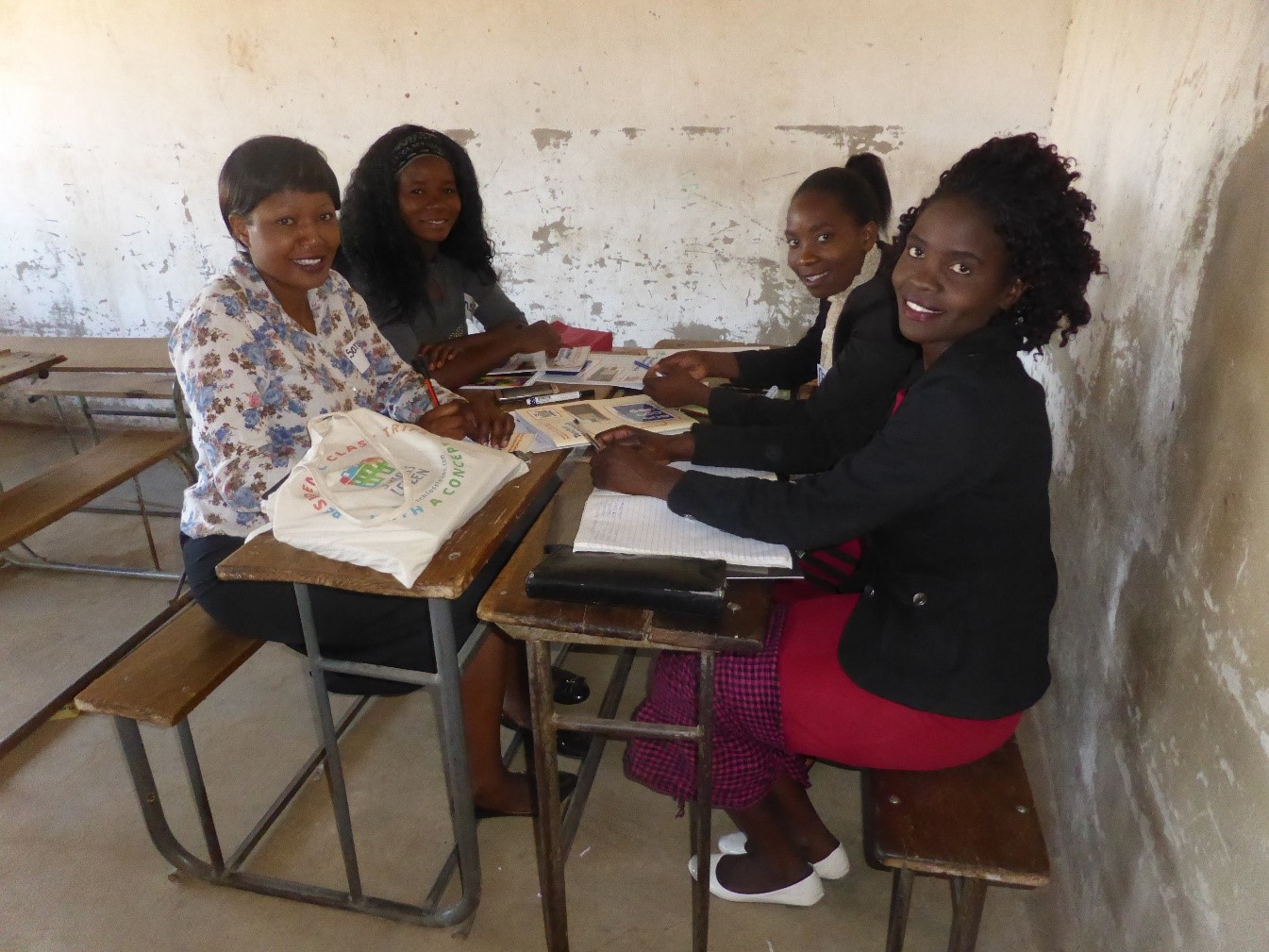Training guide
| Site: | OpenLearn Create |
| Course: | Active teaching and learning for Africa (6): Being a reflective practitioner |
| Book: | Training guide |
| Printed by: | Guest user |
| Date: | Friday, 21 November 2025, 3:34 PM |
1. Introduction
Welcome back!
Over the last two years, you have been working on the ‘Active teaching and learning for Africa’ enhanced SPRINT programme to develop more active teaching approaches, and to work more collaboratively with other teachers.
These resources are designed to support active teaching and learning in line with the revised Zambian school curriculum. The programme provides resources for six terms (two school years), but it can be extended and revisited over more terms, changing the focus based on each school’s or district’s priorities, for example, inclusive education, literacy support or formative assessment. The resources will be the focus of your Teacher Group Meetings (TGMs) and will provide ideas for collaboration, planning, discussion and reflection among teachers.
In Year 1, you covered nine teaching approaches in the three courses.
Course 1: Classroom management for learner-centred teaching
- using questioning to promote thinking
- using pair work
- using the local community/environment as a resource.
Course 2: Inclusive teaching
- using group work in your classroom
- storytelling, songs, games and role-play
- involving all learners.
Course 3: Assessment for learning
- monitoring and giving feedback
- eliciting prior knowledge
- assessing learning.
In Year 2, the aim is to consolidate this learning by focusing on:
- Course 1: Managing and supporting learner-centred classrooms.
- Course 2: Literacy across the curriculum.
- Course 3: Being a reflective practitioner.
The resources have provided you with ideas for activities to do during TGMs and information about different teaching approaches, including classroom examples for you to analyse and adapt.
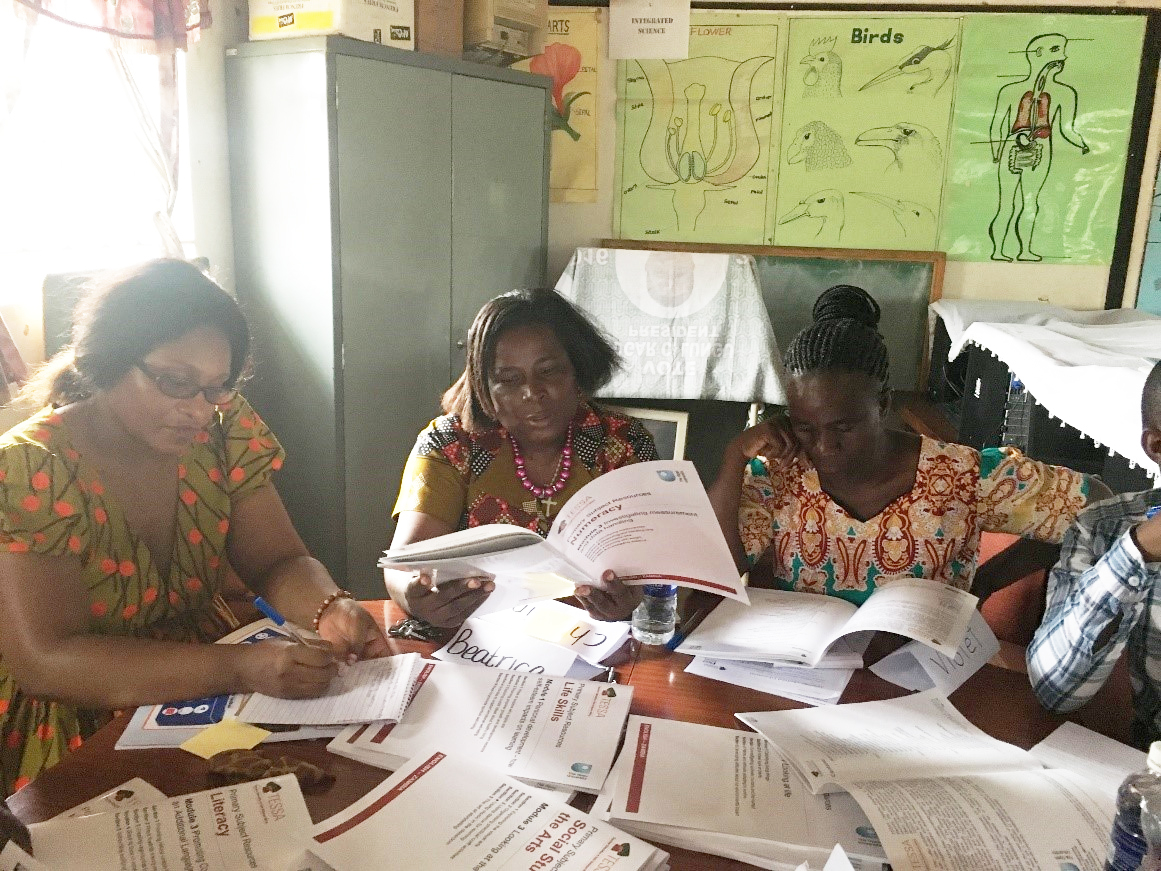
Teachers in Kabwe working with TESSA Resources to plan activities.
The purpose of these final resources is to consolidate your learning, and to provide tools that will enable you to continue with this way of working in the future.
2. A toolkit for active teaching
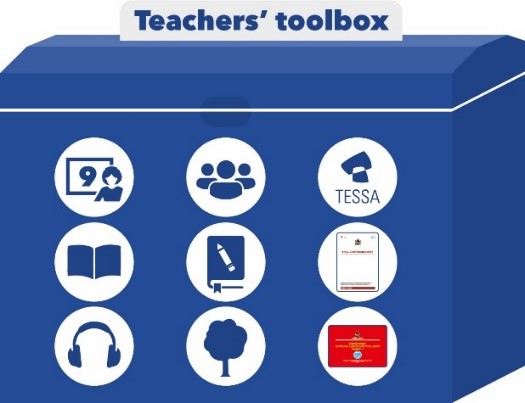
This enhanced SPRINT programme has provided a number of tools to support you in developing your teaching skills.
Activity 6.1: A toolkit for teachersWorking on your own, identify what each icon in the toolkit represents. Share your ideas with a partner. As a group identify how each of the items in the toolkit has supported your learning and teaching. If you have access to a large piece of paper, make a poster about the toolkit for the staffroom wall. |
At the end of this course, no further additional resources will be provided to help you structure your TGMs, but all the tools will remain. In the final section of this course’s resources, you will be encouraged to work as a group to plan how to carry on working collaboratively and use the resources available to continue to plan engaging, participatory TGMs. In this course, the training materials are divided into three sections:
- consolidating your learning
- personal development planning
- working with resources.
3. Consolidating your learning
Together with your colleagues, you are now designing learner-centred classroom activities, based on the nine teaching approaches, and linking them together to plan engaging lessons in which learners are actively involved. At the start of this programme, you completed a quiz on learner-centred education. If you have time, this would be a good time to re-visit that quiz!
You were also introduced to some criteria which will help you to be more learner centred. These are:
A learner-centred teacher:
- Takes account of the needs of all learners.
- Takes account of what learners already know.
- Believes that all learners can learn given the right support.
- Plans lessons carefully but is flexible when required.
- Plans engaging activities which support learning.
- Encourages learners to talk about their ideas.
- Relates learning to everyday life.
- Adopts a variety of teaching approaches.
- Provides the opportunity to learn knowledge, skills and values.
As you evaluate your own teaching and undertake peer-observations (when possible), you can use these criteria to reflect on what you are doing well, and what aspects of your teaching you could improve.
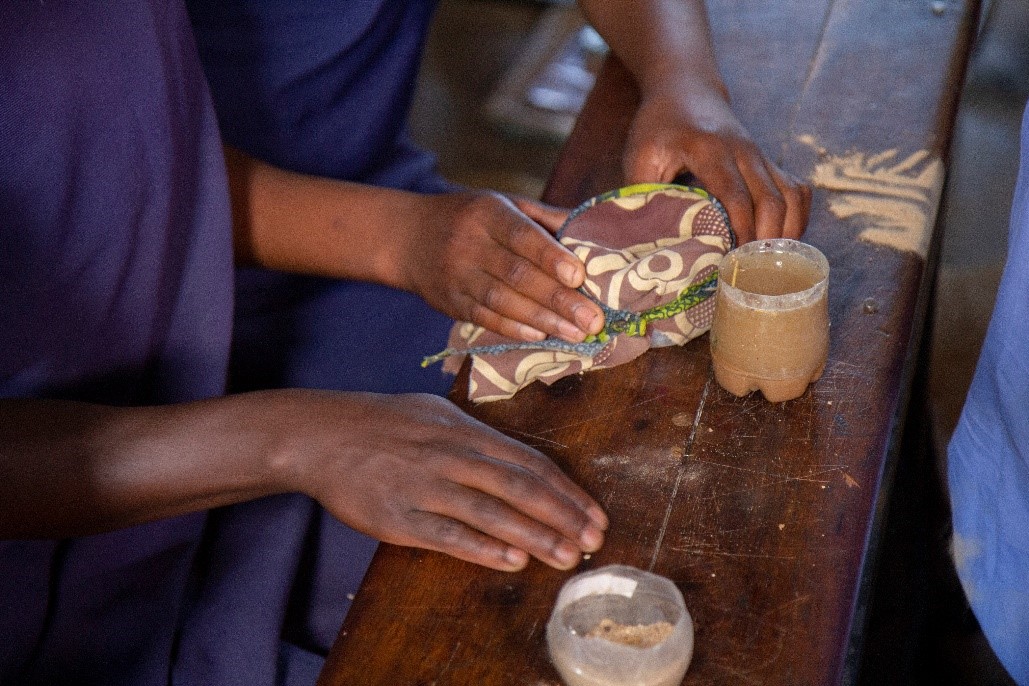
Learners undertaking a science experiment in Classroom Example 6.1.
Classroom Example 6.1: Grade 7 science lessonListen to Audio 6.1, or read the transcript with a colleague. In your Teacher Notebook, write the different ways in which teacher Fridah meets the learner-centred teacher criteria. Please note that not all criteria will be met in every learner-centred lesson.
Audio transcript Fridah was teaching science to Grade 7. They were learning the ways to separate mixtures. Fridah had ready a large jar of muddy water, paper cups, squares of two types of material (cotton and muslin), a saucepan full of cabbage and water, and a colander. Fridah gathered her equipment at the front. She held it up as she talked so everyone could see. She asked if anyone would like a drink. ‘Yes please’, came a shout. She poured some of the dirty water into a paper cup and offered it to George. ‘Would you like this?’ ‘No thank you’, said George, and everyone laughed. Then she held up the saucepan of cabbage and asked them how they would separate it from the water. Someone had spotted the colander and said, ‘use that’. Fridah poured the water and cabbage into the colander. She asked the students to explain how it worked to the other person next to them. She asked Martha and Phyllis to explain their answer to the class. They did not give quite enough detail, so she asked a few other pairs. Once they had established that the holes were too small to let the cabbage through, she asked them how they could separate the mud from the water. After a few contributions, a plan emerged: pour the muddy water through something with holes in – but the holes needed to be very small. She asked three pairs to join together and form a group. Each group sent one person to collect a cup of muddy water, two empty cups and two pieces of material. She told them that the aim was to find out which material worked best for cleaning water. As a group they worked out what to do and one person drew a diagram. Fridah went around and questioned them about how they would make sure it was a fair comparison, hoping they would realise that they needed to stir the dirty water. Then they tried it. Fridah drew a table on the chalkboard with two columns – one for the cotton and one for the muslin. When they finished, each group had to put a tick in the column which had the cleanest water. At the end there were eight ticks in the ‘cotton’
and two ticks in the ‘muslin’. She wrote three questions on the board for students to discuss in their groups.
When everyone had finished, she asked a group to answer questions 1 and 2. Then she asked another group if they agreed and if they wanted to add anything to the answer. Finally, she asked a third group to answer question 3. There followed a lively discussion and eventually one of the groups who ticked the ‘muslin’ column admitted that they had not stirred the water, so in the muslin experiment all the mud was at the bottom. This meant they could not do a fair comparison. Fridah showed the class a column that she had made from an old pipe. She had filled it with sand and put a piece of muslin at the bottom to hold the sand in. She poured some muddy water in the top. While they waited, she asked the class to draw a diagram of the apparatus they used in their exercise book and write a few sentences about what they did and why it worked. After about ten minutes, they were all thrilled to see clean water come out of the bottom of the column. Fridah finished the lesson by explaining that this is what happens to water before it goes to the system and into our taps. Sometimes chlorine is added as well to kill bacteria. She asked what advice they would give to a household that was collecting their drinking water from a river. Finally, Fridah pointed out that with 8/10 ticks in the column they could be reasonably confident that cotton was the ‘best’, but in all scientific experiments there was likely to be some uncertainty. |
|
Did you notice...
|
3.1. Planning and reflecting on learner-centred teaching
Activity 6.2: Analysing teachingWorking with a colleague, plan a lesson that you will teach next week. Make sure that the lesson meets as many of the learner-centred teacher criteria as you can and that it includes at least three of the approaches you worked on last year: questioning, pair work, using local resources, group work, role-play, games and storytelling, involving all, eliciting prior knowledge, assessment for learning, and monitoring and feedback. In your Teacher Notebook, write the criteria your lesson will aim to meet. Remember, it might not be possible to meet all the criteria in every lesson, but during a week you should try to meet them all. After the lesson, go back to your lesson plan and reflect on the list of learner-centred teaching criteria you thought the lesson would address:
|
You have already engaged with some activities included in the Managing and supporting learner-centred classrooms resources. You will find that the TESSA resources have examples of classroom activities and resources that will help you to meet the criteria set out above. Don’t forget to refer to these materials if you need ideas for your lessons!
Activity 6.3: Reflecting on learner-centrednessOnce you have taught the lesson that you planned with a colleague, work together as a larger group to consider these questions:
As a group, try and identify one practical example to demonstrate each criterion. For example:
Record an example next to each of the criteria. Try to make the examples as detailed as possible, so that someone else would be able to do the activity in their class. |
4. Personal development planning
During this enhanced SPRINT programme, you have been supported to develop a number of skills. These are:
- organising learners into pairs or groups so that they can discuss their ideas
- asking good, open questions which support higher-order thinking
- making creative use of local resources
- using storytelling, role play, songs and games to support learning
- involving all learners in the lesson
- undertaking formative assessment
- giving effective feedback which helps learners develop
- linking the approaches together to plan engaging lessons
- accessing and using TESSA materials
- supporting literacy across the curriculum
- taking part in peer observation
- evaluating and reflecting on your own teaching.
Activity 6.4: Developing skills through sharing good ideasLook at the list of skills above. Look back through your Teacher Notebook and think about one activity or lesson that you are particularly proud of because you made use of some of the skills identified above. Be prepared to share it with colleagues in the next TGM, explaining briefly:
In the TGM, as you listen to your colleagues giving their example, note down any ideas that you think you could use in your own teaching, and over the next few weeks make sure you speak with the teacher who explained the example to explore how you can adapt it to your own lessons.
|
Developing your skills in teaching is a continuous journey. As you meet new classes, or move to a different school, there are always aspects of your work that you can develop further. As you proceed on your journey, keep reminding yourself what is going well and why. You can re-visit any of the resources from the last five courses, or, as you will see in the next section, explore other resources that are available.
In the next activity, you are going to make your own action plan to develop your teaching further.
If a group of you have the same priorities, you may decide to work together next term to support each other in developing that aspect of your teaching. For example, maths and science teachers in your school might be interested in developing skills to support literacy in their lessons, or Grade 2 and 3 teachers might be interested in developing strategies to support the introduction of English language to all learners.
Your head teacher or SIC might also identify a whole school priority and organise some TGMs which focus on that, for example, how to provide formative feedback from peer observations or following on a new MOGE policy. In all these cases, you should continue to maintain the strong collaborative skills developed over the past two years in this programme.
Activity 6.5: Personal development planning: My progress in learner-centred teachingBefore the TGM: Think back to the first course of this programme, and how your teaching has developed over the past five courses:
Copy the table below in your Teacher Notebook. Consider the questions above and complete the first three columns in the table for each approach. If asked for examples, try and give as much detail as possible.
At the TGM: in a group of three to five teachers, compare your table with the others. Think whether you can help anyone who might be struggling with an approach you feel confident with, and whether you can learn from a colleague who has made the most progress with a skill you find more demanding. In the final column, write their name or notes about their example and make sure you speak with them over the next weeks to discuss how you can adapt their example to your teaching. Priorities for next term: Write in your Teacher Notebook your top three priorities for next term and identify where you can get help, and who in your school can help you with these. For example, if you are finding asking good, open questions difficult, go back to course 1. If it is supporting literacy which you need to practise, look at the resources from the previous course. |
||||||||||||||||||||||||||||||||||||||||||||||||||||||||||||
5. Working with resources
This programme has enhanced your SPRINT programme in two main ways: by providing resources to support planning of learner-centred lessons, and by helping to make TGMs more collaborative and participatory. The resources provided include:
- the resources from each course of the programme with TGM activities, top tips and classroom examples
- the audio and videos included in the resources for each course
- the Revised Zambian School Curriculum, which highlights the knowledge, skills and values you have to teach
- the TESSA Curriculum guide, which links the curriculum to the TESSA resources
- TESSA subject resources
Hopefully you are familiar with these resources.
In the next activities you will be introduced to additional resources. These are:
- other TESSA materials: Working with pupils, Key Resources, Inclusive Education Toolkit
- resources to support the teaching of Early Reading
Activity 6.6: Learning through videos, audios and othersBefore the TGM: In this programme, you have watched a number of videos and listened to audios (or read the transcripts) where teachers were using a range of teaching approaches and skills to support learning. Think back to these examples and identify two you found especially helpful and had an impact in your teaching. In your Teacher Notebook, write some notes about:
In the TGM In a group of three to five teachers, share the video/audio/transcripts you found helpful. Were your choices all the same? Is there anything you can learn from some of your peers’ suggestions? You might want to make a poster to identify the most useful videos with the information you wrote in your Teacher Notebook, so that teachers have easy access if they need an idea of a useful learner-centred activity. |
In the next section, you will take some time to explore what else is available, and to work with your SIC and other teachers to find ways of sharing physical resources and good ideas.
5.1. Working with resources (2)
In the next three activities, you are encouraged to explore some of the other resources available to support learner-centred teaching. Each set – the TESSA Key Resources, the Inclusive Education Toolkit and Teaching Early Reading – has material that you could explore individually, or it could form the basis of your TGMs for a whole term. SICs and TGM facilitators can use the ideas in the resources for courses 1–6 to plan appropriate TGM activities which encourage discussion of the issues.
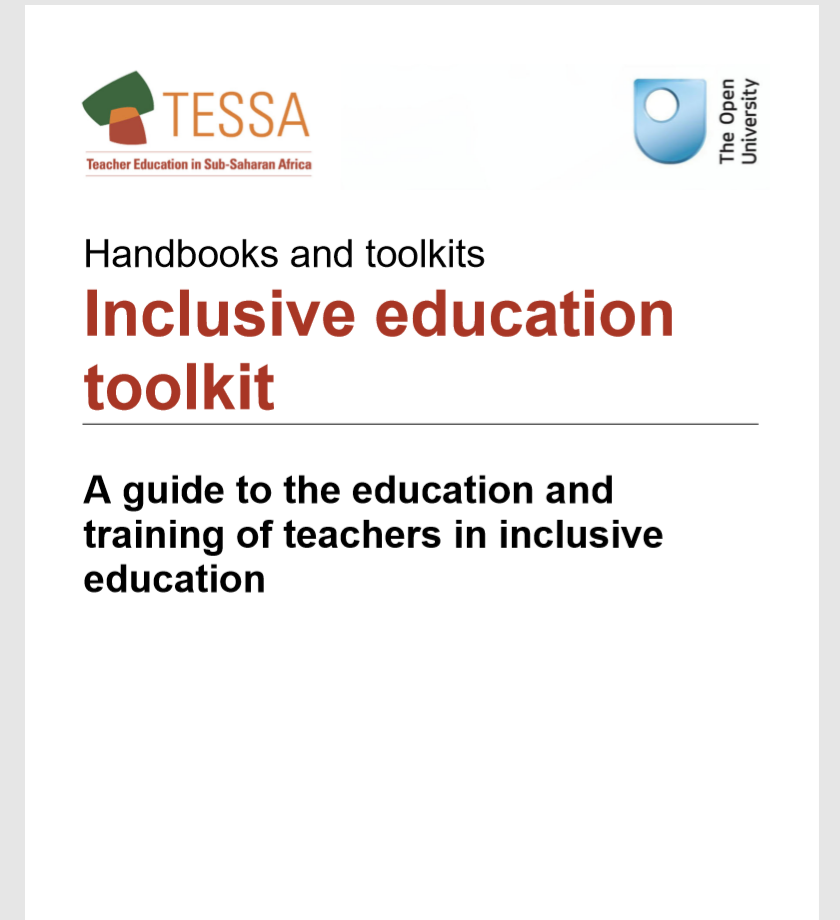
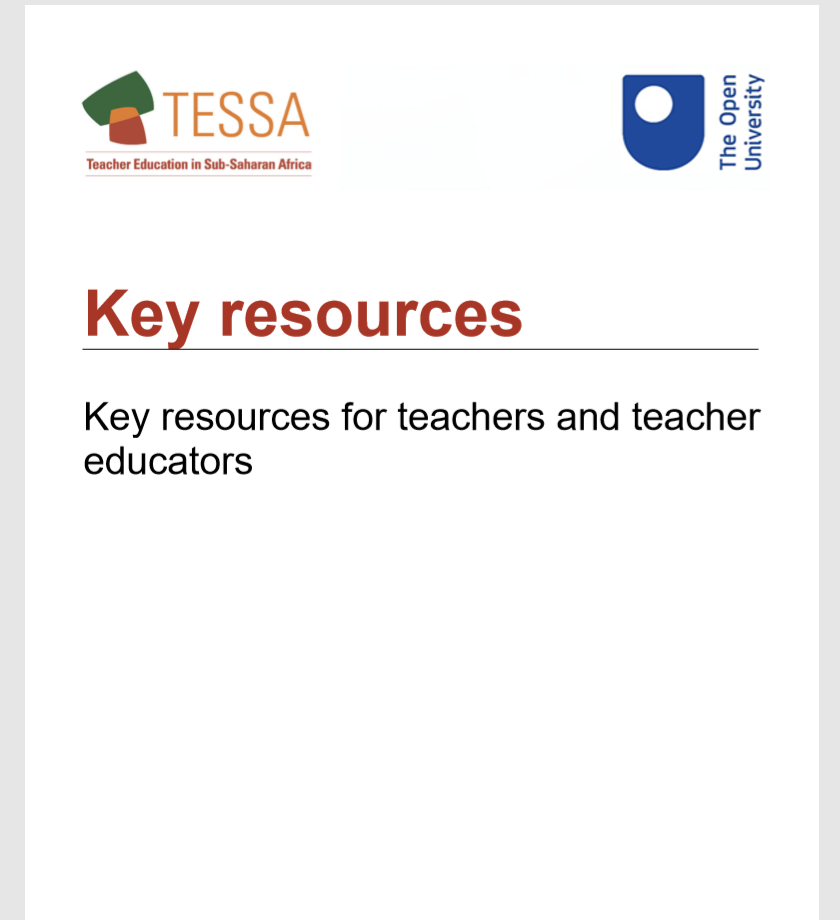
Activity 6.7: Exploring the TESSA Key Resources (group 6 above)Look at the TESSA Key Resources. You will recognise some of these from the work you have been doing over the past two years (i.e. using questioning, group work, roleplay, brainstorming etc), but you will also find some new ones (i.e. using mind maps, investigations or new technologies in your lessons, or working with multi-grade classes). Identify two or three which you think will be helpful. Work with a colleague to explain why you think this might be helpful. Plan a classroom activity that makes use of one of the ideas from this resource. The Key Resources set out the principles of the resources, and you can find many examples of how they can be used in the TESSA subject resources. |
Activity 6.8: TESSA Inclusive Education ToolkitLook at the TESSA Inclusive Education Toolkit. Write down the seven principles of inclusive education. Work in pairs to examine one of the principles. Report back to the group about what you learned. If everyone agreed, this resource could form the basis of your TGMs for a whole term. |
Activity 6.9: Teaching Early Reading.If you are involved in teaching pre-school, Grades 1 or 2, have a look at the ‘TESSA Teaching Early Reading – with African Storybook’ resources. The course is available as a set of PDFs as part of the enhanced SPRINT resources. This will give you ideas to use in your classroom that will support the teaching of reading in the lower primary school. To get the full benefit from it, however, you would need to study it online. TESSA Teaching Early Reading - with African Storybook With your colleagues, make a plan about how and when you might use these resources. Again, this resource could form the basis of a whole term’s TGMs. |
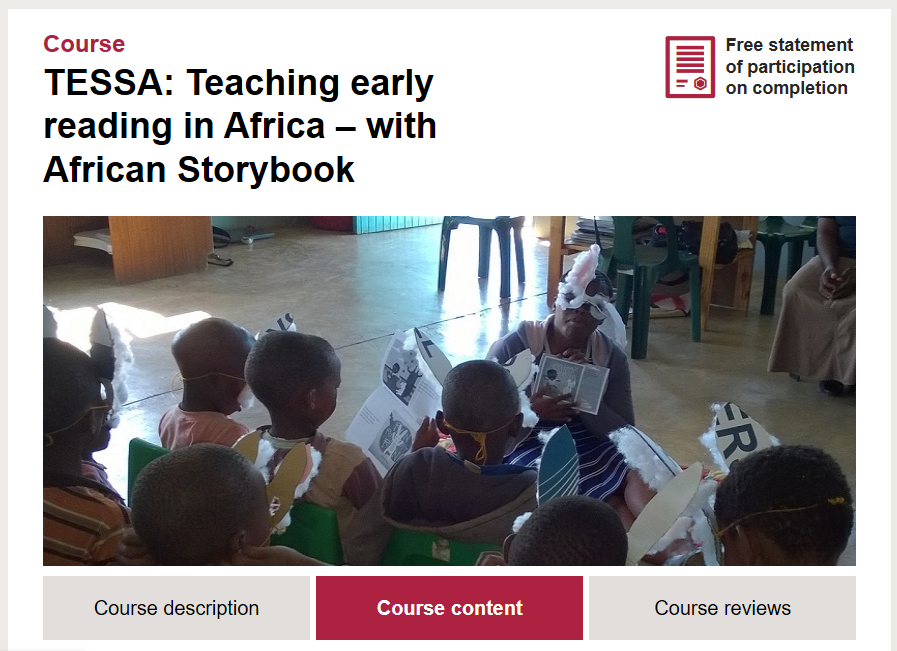
6. Summary: Being a reflective practitioner
This enhanced SPRINT programme has used the structures and ways of working familiar with teachers as part of their school-based continuing professional development; but has enhanced them through the provision of resources and a systematic approach to TGMs. You have been encouraged to adopt a theme each term, and all the TGMs have been used to develop your understanding of that theme.
Activity 6.10: School development planningThis enhanced SPRINT programme has offered you the opportunity to explore different ways to
After having explored the additional resources in the previous activities, as a group, discuss what extra resources you need, and consider how you could work together to create them. Can you share resources between teachers? With other schools? Remember that you can often adapt teaching resources to use in different grades and subjects, so it is important to continue speaking with colleagues who might be teaching a different subject or in a different grade, as you have been doing over the past two years with the resources provided as part of the enhanced SPRINT programme. Now in your TGM, complete the table below with what you have done so far, and what you can do in future to continue to develop your teaching and support your learners. This could be the start of your enhanced SBCPD plan for next year.
|
Activity 6.11: Impact on teaching and learningWatch the DESO from Chisamba district as she speaks about the impact of this enhanced programme on teaching and learning. What are the two key points that she identifies? |
In the future, you are encouraged to carry on using this approach, to work together to plan and evaluate classroom activities which actively engage learners, and to induct new teachers into this way of working. The themes you choose may be the same as those you have already covered, in which case you can re-visit the materials.
Alternatively, new priorities may emerge, in which case you can probably find some relevant resources or develop some of your own that can be shared. When sharing resources make sure you provide useful information for someone else to use (such as what grade, subject, topic you used it in, and how learners reacted or any changes you made to it), and store them safely in the school, on a computer or a suitable device. Some resources that may interest you are included in Additional Resources.
Activity 6.12: Reviewing your learning Quiz |
